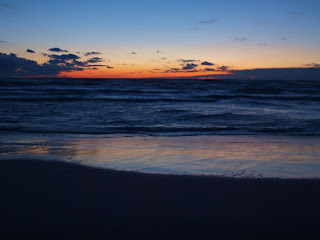 Roaming the Dunes on Curonian Spit
Roaming the Dunes on Curonian SpitThe funny thing is, running into a deer with our car was one of the less memorable parts of our day driving across Lithuania. Sure, the front of the car got slightly bent out of shape; the driver (none other than yours truly) was a bit shaken up by the sight of Bambi bouncing off the bumper; and the four other passengers were temporarily reduced to screaming, stressed-out captives. But in a day jam-packed with sights and stories, the one about the accident ranks down on the list.
Let me backtrack a bit and start from the beginning. Our weekend in Lithuania, the southern-most of the Baltic states, was spent with three of Kyle's friends from England who had taken some time off work to join us on our adventure. Lithuania is one of those places, like Timbuktu, that one hears of in passing, might be able to find on a map, but really has no idea what is in it or why on Earth someone would go there. And walking around the capital, Vilnius, which apparently is the country's biggest city but could have been mistaken for a ghost town the weekend we visited, my questions as to the allure of the place only grew.
That all changed when the five of us hopped into our rental car and set off on a cross-country drive (of 400 kilometers). The Lithuanian countryside is gorgeous: the narrow roads snake past gently rolling hills. Cobalt-blue lakes contain picturesque castles on islands, connected to the mainland by drawbridges straight out of a fairy tale.
 Trakai Castle
Trakai CastleOur first stop of the day was the Hill of Crosses, a Catholic pilgrimage site for the past few centuries that gained increase importance during the Communist years, when it became the place to quietly protest the ruling regime. There are around 200,000 crosses on this hill alone, so many that it's impossible to get a sense of the topography of the land-- the crosses just seem to rise like trees from the flat ground.
 A small percentage of the crosses on the Hill of Crosses
A small percentage of the crosses on the Hill of Crosses
Two hundred kilometers past the Hill of Crosses, we reached the coast, where we caught a 3 minute ferry ride to the
Curonian Spit. At 100 kilometers long, it's the world's largest and spit, a giant sand dune barrier between the Baltic Sea and the Lithuanian shore. After getting off the ferry, we quickly crossed the 1 kilometer width of the spit and watched a glorious sunset from the beach.
 Baltic sunset
Baltic sunset
Darkness upon us, we set off driving the 40 kilometers we had left before our destination, the town of Nida. A narrow road through a forest late at night is never the set-up for a cheery story, and this one was no exception. I'll skip the details, but a brief summary is that the deer survived and ran off, the car was only cosmetically damaged, and no human was injured.
That adventure in the books, we proceeded to Nida, where we had hoped to be able to find a place to stay without making a reservation. Imagine our surprise when we drove into town and found ZERO sign of life. No people on the streets. No lights shining through any windows. No open hotels. After a brief and slightly frantic search, we found the only open hotel in town, a huge place in which we were the only guests.
 Some graffiti we found the next morning next to our hotel
Some graffiti we found the next morning next to our hotel
The next morning, thing returned to normal. The drive back to Vilnius was uneventful, Kyle's friends returned to England, and he and I boarded an overnight bus that took us to Warsaw, Poland. But our time in Lithuania was fab: it's perhaps the only place in the world where in one day, you can go from city to sacred pilgrimage site to giant sand spit, with a little wildlife thrown in there, too.